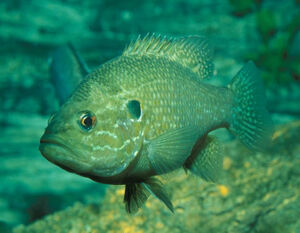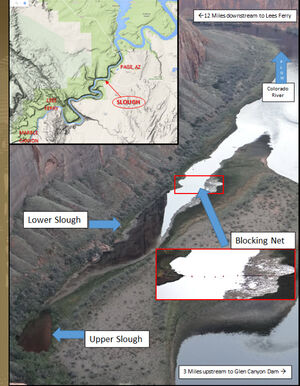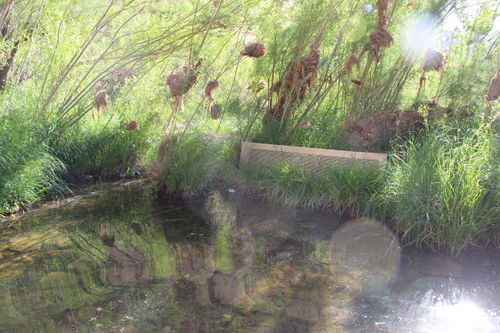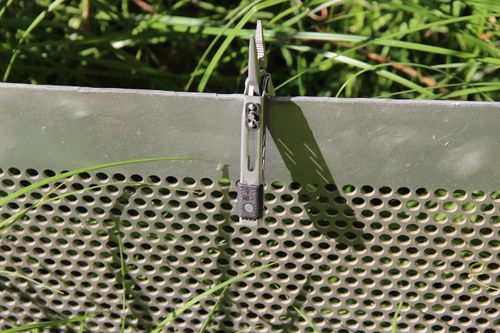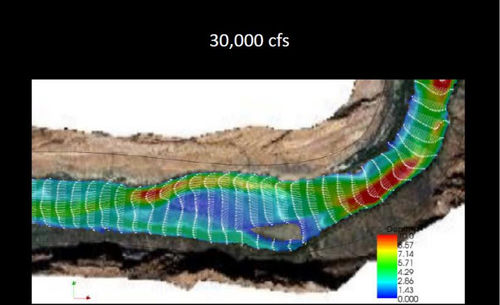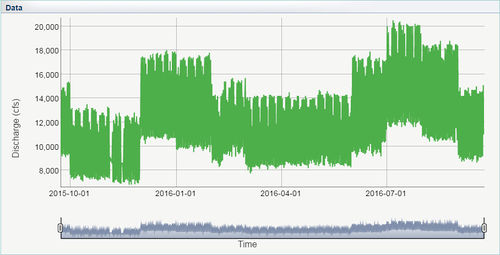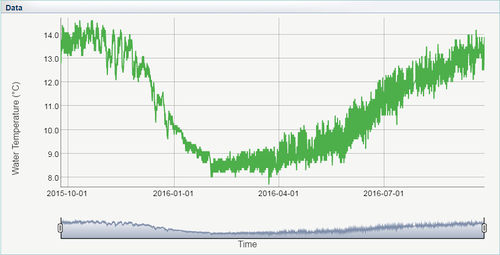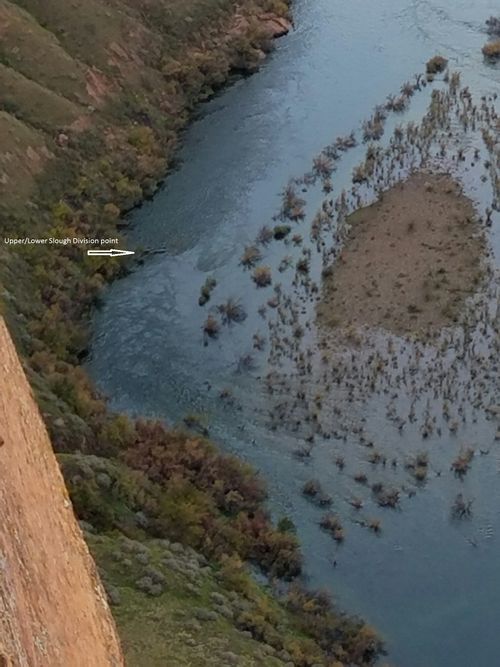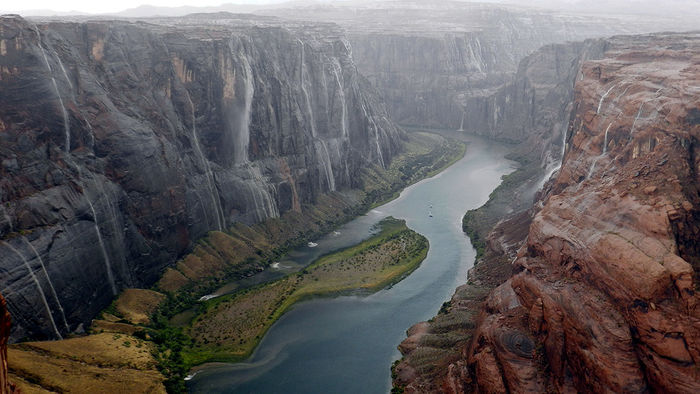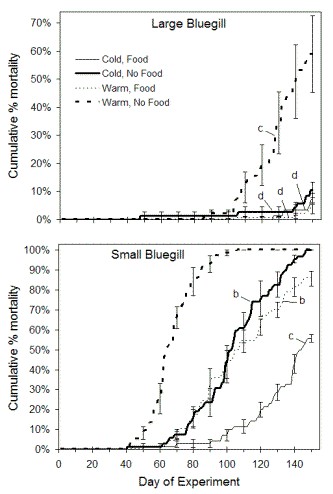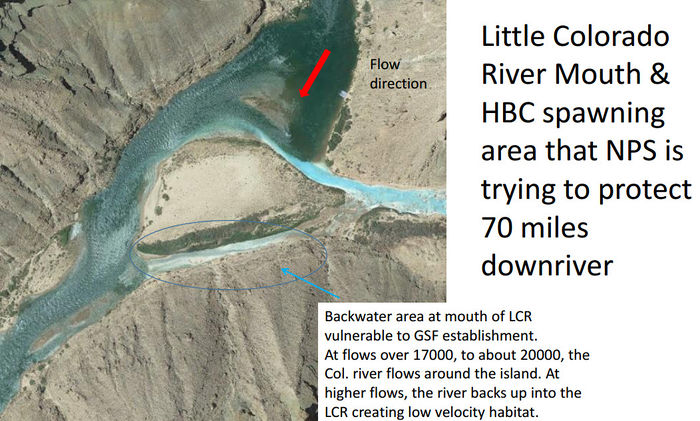Difference between revisions of "Green Sunfish Page"
Cellsworth (Talk | contribs) |
Cellsworth (Talk | contribs) |
||
| (3 intermediate revisions by the same user not shown) | |||
| Line 17: | Line 17: | ||
</table> | </table> | ||
| − | [[File:GreenSunfish2.jpg|center| | + | [[File:GreenSunfish2.jpg|center|300px]] <br> |
| − | [[File:Slough.jpg|center| | + | [[File:Slough.jpg|center|300px]] <br> |
<!-- | <!-- | ||
| Line 25: | Line 25: | ||
|style="width:60%; font-size:120%;"| | |style="width:60%; font-size:120%;"| | ||
| − | ==''' | + | == '''Green Sunfish (''Lepomis cyanellus'')'''== |
| − | + | Green sunfish were earliest of the smaller sunfishes to be introduced into Arizona, first being | |
| − | + | collected in 1926 (Minckley 1973). It is characterized by its large mouth with bluegreen | |
| + | striations on the cheeks. The opercle flap is black with a reddish or orange border. The body | ||
| + | is olivegreen in color, with dark vertical bars on the sides. The pectoral fin is short and | ||
| + | rounded and the caudal fin and lower fin margins are white or yellowish with dusky spots at | ||
| + | the rear of the dorsal and anal fins. Length is about 3 to 12 inches with the typical weight | ||
| + | ranging between 3 ounces to 1 pound 8 ounces (AGFD 2006). | ||
| − | + | The green sunfish can be found in most warm water lakes and streams in Arizona and even | |
| − | + | in a few trout lakes in the White Mountains and Mogollon Rim. This fish is highly adaptable, | |
| + | but tends to become most abundant in rocky situations of either lakes or streams, where | ||
| + | other sunfish are absent or uncommon. | ||
| − | + | Green sunfish will eat anything they can catch and swallow. Insects, crayfish, fish and frogs | |
| − | + | are all in danger when green sunfish are present. | |
| − | + | Green sunfish are remarkably tolerant of crowding among themselves. Under such | |
| − | Green sunfish | + | conditions, they often become stunted in size creating management problems in small lakes. |
| + | Large populations apparently compete with the young of other fishes for food, or prey upon | ||
| + | them, thus causing negative impacts to both game and native fishes (Minckley 1973). | ||
| − | + | Green sunfish is the most piscivorous member of its genus (Dudley and Matter 2000). | |
| − | Green sunfish | + | According to Moyle and Nichols (1973, 1974), green sunfish were probably responsible for |
| − | + | the elimination of California roach (Hesperoleucus symmetricus) in the San Joaquin valley of | |
| − | + | California because of heavy predation on the young. In a study in North Carolina (Lemly | |
| − | + | 1985), removal of green sunfish from streams led to the increase in the biomass and | |
| − | + | numbers of most native species. [https://www.usbr.gov/lc/phoenix/biology/azfish/pdf/greensunfish.pdf] | |
| − | + | ||
| − | + | ||
| − | + | ||
| − | + | ||
| − | + | ||
|}<!-- | |}<!-- | ||
| Line 129: | Line 133: | ||
|style="color:#000;"| | |style="color:#000;"| | ||
| + | *[http://gcdamp.com/index.php?title=Nonnative_Invasive_Aquatic_Species Nonnative Invasive Aquatic Species] | ||
| + | *[http://www.nwrc.usgs.gov/wdb/pub/hsi/hsi-015.pdf Habitat Suitability Index Models: Green Sunfish] | ||
*[http://gcdamp.com/index.php?title=National_Park_Service_Expanded_Non-native_Aquatic_Species_Management_Plan_and_EA 2019 National Park Service Expanded Non-native Aquatic Species Management Plan] | *[http://gcdamp.com/index.php?title=National_Park_Service_Expanded_Non-native_Aquatic_Species_Management_Plan_and_EA 2019 National Park Service Expanded Non-native Aquatic Species Management Plan] | ||
*[http://gcdamp.com/index.php?title=2013_National_Park_Service_Comprehensive_Fisheries_Management_Plan 2013 National Park Service Comprehensive Fisheries Management Plan] | *[http://gcdamp.com/index.php?title=2013_National_Park_Service_Comprehensive_Fisheries_Management_Plan 2013 National Park Service Comprehensive Fisheries Management Plan] | ||
*[[GCDAMP 2016 Fish PEP| 2016 Fish Protocol Evaluation Panel (PEP)]] | *[[GCDAMP 2016 Fish PEP| 2016 Fish Protocol Evaluation Panel (PEP)]] | ||
*[http://gcdamp.com/index.php?title=The_HFE_Page The High Flow Experiment (HFE) Page] | *[http://gcdamp.com/index.php?title=The_HFE_Page The High Flow Experiment (HFE) Page] | ||
| − | |||
*[http://youtu.be/dq3yvvEjsOo| Demo video that shows how to do an ammonia treatment to remove invasive aquatic species] | *[http://youtu.be/dq3yvvEjsOo| Demo video that shows how to do an ammonia treatment to remove invasive aquatic species] | ||
| Line 186: | Line 191: | ||
|- | |- | ||
| − | ! <h2 style="margin:0; background:#cedff2; font-size:120%; font-weight:bold; border:1px solid #a3b0bf; text-align:left; color:#000; padding:0.2em 0.4em;"> | + | ! <h2 style="margin:0; background:#cedff2; font-size:120%; font-weight:bold; border:1px solid #a3b0bf; text-align:left; color:#000; padding:0.2em 0.4em;">Other Stuff</h2> |
|- | |- | ||
|style="color:#000;"| | |style="color:#000;"| | ||
| − | |||
| − | |||
| − | + | [[File:GSF Sloughs Rainstorm Sep-2-2016.jpg|center|700px|thumbnail| http://gcdamp.com/images_gcdamp_com/d/d2/Glen_Canyon_Sloughs_%26_Green_Sunfish_Control_Email_Version.pdf ]] | |
| − | + | '''Description:''' | |
| + | Native to the Great Lakes, Hudson Bay and the Mississippi River basin. Introduced into Arizona in 1926. Large mouth with blue-green striations on the cheeks. Opercle flap is black with reddish or orange border. Bodies olive-green in color, dark vertical bars are faintly seen on sides. Pectoral fin short and rounded. Caudal fin and lower fin margins are white or yellowish with dusky spots at rear of dorsal and anal fins. Length: 3 to 12 inches. Weight: 3 ounces to 1 pound 8 ounces. May live to nine years. | ||
| − | + | '''Location and Habitat:''' | |
| − | + | Found in most seasonally warm water lakes and streams in Arizona. Prefer lakes with rocky substrate and piles of rubble, but can be found in slow moving rivers and riverine backwaters. Green sunfish have been found at a wide range of stream gradients, varying from 0.2 to 5.7 m/km; however, they are most abundant at lower (<2 m/km) gradients. They prefer small to medium-sized (<30 m width) streams.[http://www.nwrc.usgs.gov/wdb/pub/hsi/hsi-015.pdf] Being native to the Great Lakes and Mississippi River Basin, green sunfish are well suited to tolerate long periods of cold water. | |
| − | + | ||
| − | + | '''Temperature:''' | |
| − | + | Being native to the Great Lakes and Mississippi River Basin, green sunfish are well suited to tolerate long periods of cold water. The summertime temperature preference for adult green sunfish is 28.2° C and, when possible, they avoid temperatures above 31° C or below 26° C. Growth and food conversion efficiency increase as temperature increases from 13.2 to 28° C. Optimal temperatures for fry range from 18 to 26° C. The range of tolerance for bluegill fry is 10 to 36° C, and it is assumed that green sunfish fry tolerances are similar. Temperature requirements for juveniles are assumed to be the same as those for adults.[http://www.nwrc.usgs.gov/wdb/pub/hsi/hsi-015.pdf] 2015-2016 temperatures in the mainstem ranged from 8.0-15.5 C between Lees Ferry and the Little Colorado River. 2015-2016 temperatures in the Little Colorado River ranged from 10.0-28.0 C and are within the temperature tolerances of green sunfish spawning and growth. | |
| − | + | ||
| − | + | ||
| − | [[ | + | '''[http://gcdamp.com/index.php?title=GCDAMP_Sediment| Turbidity] and Dissolved Oxygen:''' |
| + | Green sunfish tolerate greater turbidity and lower dissolved oxygen than other sunfish.[http://www.dnr.state.mn.us/fish/sunfish/biology.html] Moderate (25-100 JTU) turbidities correlated with high species abundance are optimum.[http://www.nwrc.usgs.gov/wdb/pub/hsi/hsi-015.pdf] Ventilation rates were not affected by bentonite clay suspensions below 2,125 FTU at 5 C, 1,012 FTU at 15 C, and 898 FTU at 25 C. At turbidity levels exceeding 1,012 FTU at 15 C and 898 FTU at 25 C ventilation rates increased 50-70%. Oxygen consumption rates were not affected by turbid suspensions of up to 3,500 FTU at any of the four temperatures.[http://www.tandfonline.com/doi/abs/10.1577/1548-8659(1976)105%3C107%3AEOTOVR%3E2.0.CO%3B2] | ||
| + | |||
| + | '''Salinity:''' | ||
| + | Green sunfish have preferred salinity tolerances <0.36% and will not tolerate salinity >0.56%.[http://www.nwrc.usgs.gov/wdb/pub/hsi/hsi-015.pdf] The Little Colorado River has a naturally high salinity at baseflow ranging from 0.22% - 0.36%.[https://pubs.er.usgs.gov/publication/70040717] | ||
| + | |||
| + | '''Reproduction:''' | ||
| + | Optimal temperature for spawning and subsequent development ranges from 20 to 27° C. Spawning will not occur below 19° C or above 31° C.[http://www.nwrc.usgs.gov/wdb/pub/hsi/hsi-015.pdf] Males build nests in shallow pools over gravel, sand or bedrock. The nests are usually within a couple feet of each other. The male guards the nest and hatched fry. Males constantly show defensive displays and fight with other males who come too close. It is thought that green sunfish may produce the same number of eggs as bluegill, which is roughly 50,000 eggs per female. It takes normally 1 to 2 days for the eggs to hatch and another 5 to 7 days of protection from the male until the fry become independent. Green sunfish can spawn up to every 8 to 10 days during the spawning season.[http://www.biokids.umich.edu/critters/Lepomis_cyanellus/] | ||
| + | |||
| + | '''Food:''' | ||
| + | Green sunfish will eat anything they can catch and swallow. Aquatic and terrestrial insects and invertebrates are the most common food items. Small crayfish, humpback chub, and frogs are all in danger when green sunfish are present. Young life stages of chub do not persist in streams occupied by Green Sunfish. No recruitment of young-of-year Gila Chub (''Gila intermedia'') occurred in the presence of sunfish in Sabino Creek, Arizona (Dudley and Matter, 2000). | ||
| + | |||
| + | '''Risk:''' | ||
| + | Green sunfish may temporarily be displaced into colder more unfavorable environments where survival might be lower, but the fish that do survive will seek out warm backwaters and tributaries after moving downstream. An upstream source that continues to allow new individuals to disperse downstream and colonize tributaries, when they are not in flood stage, greatly increases the likelihood of sunfish establishment in tributaries of the CRe. If no action is taken, there is a high risk of sunfish spreading downstream and becoming established in and near other tributaries, primarily the Little Colorado River, where negative impacts to the endangered humpback chub will occur.[[Media:Green sunfish RA Sept 30 2015-final.pdf| (Green Sunfish Risk Assessment)]] | ||
==[https://experts.illinois.edu/en/publications/body-size-food-and-temperature-affect-overwinter-survival-of-age- The Effect of Temperature and Food Availability on Size-Specific Overwinter Survival in Age-0 bluegill.] == | ==[https://experts.illinois.edu/en/publications/body-size-food-and-temperature-affect-overwinter-survival-of-age- The Effect of Temperature and Food Availability on Size-Specific Overwinter Survival in Age-0 bluegill.] == | ||
| Line 219: | Line 233: | ||
[http://gcdamp.com/images_gcdamp_com/d/d2/Glen_Canyon_Sloughs_%26_Green_Sunfish_Control_Email_Version.pdf Establishment of a green sunfish population at the slough at the mouth of the LCR would be especially problematic in terms of difficulty to control and potential to affect humpback chub.] | [http://gcdamp.com/images_gcdamp_com/d/d2/Glen_Canyon_Sloughs_%26_Green_Sunfish_Control_Email_Version.pdf Establishment of a green sunfish population at the slough at the mouth of the LCR would be especially problematic in terms of difficulty to control and potential to affect humpback chub.] | ||
| + | |||
| + | |- | ||
| + | ! <h2 style="margin:0; background:#cedff2; font-size:120%; font-weight:bold; border:1px solid #a3b0bf; text-align:left; color:#000; padding:0.2em 0.4em;">Acceptable Risk Calculations for GSF</h2> | ||
| + | |- | ||
| + | |style="color:#000;"| | ||
| + | *[[media:Propagule-melissa-2016.pdf| Consideration of Propagule Size in the Establishment of Nonnative Fish in Reservoirs & Rivers]] | ||
| + | *[[media:BASINWIDENNFSTRATEGYFeb2014.pdf| see Appendix G: Propagule Pressure in the 2014 Upper Colorado River Basin Nonnative and Invasive Aquatic Species Prevention and Control Strategy]] | ||
| + | |||
| + | Summary of an email from Melissa Trammell (NPS) 9/7/16: | ||
| + | |||
| + | Melissa has been looking into deriving a defensible acceptable risk number of green sunfish in the lower slough before conducting an HFE this year. She has been evaluating some work done by retired FWS biologist Pat Martinez who has done extensive work evaluating illegal introductions of nonnative fish into various water bodies in the upper Colorado River Basin by looking at how many introductions, and the number of fish per introduction, were necessary before populations became established. The species Martinez examined were walleye, smallmouth bass, and northern pike; invasive species of concern in the upper Colorado River Basin. Green sunfish are most analogous to smallmouth bass in this example. If you look at slide 11 [[media:Propagule-melissa-2016.pdf| in his ppt]], Martinez calculated that it took a mean of 1.25 adult SMB (a minimum of 0.25 SMB) per surface acre of receiving water body, to establish a population in the waterbodies he evaluated. He applied this value to rivers, particularly the Yampa River, by looking at total river miles times average width to get total surface acres. The point of the analysis was that the Program's removal targets for smallmouth bass for the Yampa River were about the same as the mean number needed for establishing a population, which indicated the Program needed to adjust their removal targets down. | ||
| + | |||
| + | Melissa noted that the calculation she gives below is a very conservative estimate, since GSF is less likely to establish a population in a river environment than a lake or pond, also, the calculation assumes the fish are adult, which is not the case for the GSF in the sloughs - they are primarily young-of-year. The calculation for the Colorado River below the sloughs down to the Little Colorado River, which is our area of primary concern, and applying the minimum of 0.25 fish per surface acre, suggests that 656 GSF released from the sloughs could establish a population somewhere in the Colorado River between Glen Canyon and the LCR. Given David Ward's (GCMRC) calculation that we captured about 12% of the total number of GSF present on any single electrofishing pass last year, that means a theoretical one-pass capture of 78 fish likely would represent a total population in the lower slough of 656 fish. Clay Nelson (GCMRC) only captured 4 (counting the ones in the little channel) in 40 minutes of sampling in the lower slough indicating that there were only about 33 GSF present in the lower slough when he sampled. Subsequent sampling on Sept 1-2 only produced 10 GSF in the lower slough; much lower densities than this risk assessment would consider problematic. Last year, in the lower slough, we removed about 1,800 GSF before the treatment, and collected about 200 afterwards. AGFD has suggested 100 GSF in the lower slough as an upper limit for an acceptable risk number and Ken (GCNRA) suggested 5 mature GSF/hour electrofishing. These are both much more conservative targets than the above calculations. | ||
| + | |||
| + | In summary, Melissa suggests that a very conservative acceptable risk value for the number of GSF in the lower slough prior to an HFE would be 300 GSF of any size, about 50% of the value calculated from Martinez' analysis. This number could either be calculated from depletion estimates as we progress through the removal effort, or by using 12% as the capture probability, thus a final pass should produce less than 36 total fish (12% of 300). If the number of fish remaining in the lower slough after all mechanical removal efforts is greater than that, she suggests moving towards implementing another rotenone treatment of the lower slough before conducting an HFE. | ||
|} | |} | ||
Latest revision as of 15:40, 25 July 2022
|
Green Sunfish (Lepomis cyanellus)Green sunfish were earliest of the smaller sunfishes to be introduced into Arizona, first being collected in 1926 (Minckley 1973). It is characterized by its large mouth with bluegreen striations on the cheeks. The opercle flap is black with a reddish or orange border. The body is olivegreen in color, with dark vertical bars on the sides. The pectoral fin is short and rounded and the caudal fin and lower fin margins are white or yellowish with dusky spots at the rear of the dorsal and anal fins. Length is about 3 to 12 inches with the typical weight ranging between 3 ounces to 1 pound 8 ounces (AGFD 2006). The green sunfish can be found in most warm water lakes and streams in Arizona and even in a few trout lakes in the White Mountains and Mogollon Rim. This fish is highly adaptable, but tends to become most abundant in rocky situations of either lakes or streams, where other sunfish are absent or uncommon. Green sunfish will eat anything they can catch and swallow. Insects, crayfish, fish and frogs are all in danger when green sunfish are present. Green sunfish are remarkably tolerant of crowding among themselves. Under such conditions, they often become stunted in size creating management problems in small lakes. Large populations apparently compete with the young of other fishes for food, or prey upon them, thus causing negative impacts to both game and native fishes (Minckley 1973). Green sunfish is the most piscivorous member of its genus (Dudley and Matter 2000). According to Moyle and Nichols (1973, 1974), green sunfish were probably responsible for the elimination of California roach (Hesperoleucus symmetricus) in the San Joaquin valley of California because of heavy predation on the young. In a study in North Carolina (Lemly 1985), removal of green sunfish from streams led to the increase in the biomass and numbers of most native species. [1] |
| Online training |
Fish Species of the Colorado River in Lower Glen Canyon and Grand Canyon |
Fish photos, information, and maps |
|---|
|
|
